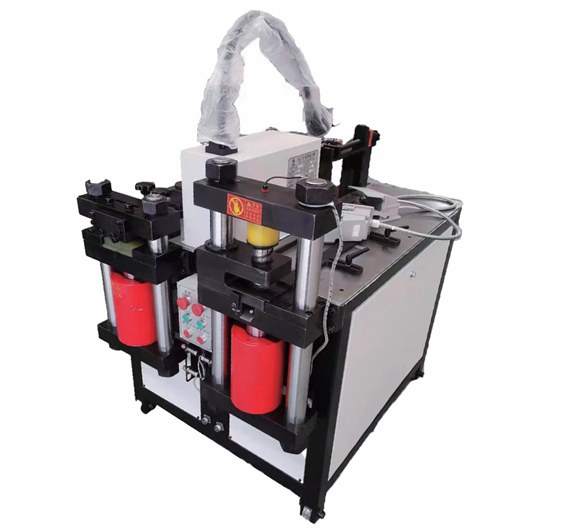Copper row processing machines are essential equipment in the power equipment, high-low voltage complete sets, and transformer manufacturing industries. They are primarily responsible for the precise punching, shearing, and bending of copper and aluminum busbars. With the advancement of industrial intelligence, the variety and functions of these machines have increased, making the selection of the right equipment for specific production needs a challenge for many engineers and procurement managers. This article provides a detailed look at copper row processing machines, covering technical parameters, functional features, and key selection considerations to help you make an informed decision easily!

1. Basic Components and Core Technologies of Copper Row Processing Machines
A standard copper row processing machine typically consists of three core workstations: the punching unit, the shearing unit, and the bending unit. The punching unit is responsible for creating precise round or elongated holes in the copper bar. Some advanced models can achieve a punching force of 400KN and handle copper bars up to 12mm thick and 250mm wide. The shearing unit acts like efficient scissors, using a file-shear design to produce smooth cuts without collapse or burrs, significantly improving the aesthetics of the finished product. The bending unit is the most technologically advanced part. Modern equipment generally uses a closed-loop control system composed of a PLC (Programmable Logic Controller) and a grating ruler. By changing the program, the bending angle can be easily adjusted, which not only solves the problem of spring-back encountered in traditional machines but also ensures angle consistency across batches, improving processing accuracy to within ±1°, with repeatability even reaching ±0.3°.
Flexible bending is a significant technological breakthrough in recent years. Simply put, by entering the copper bar's thickness and target angle into the CNC system, the system automatically calculates and executes the bending operation. It can even form complex shapes like Z-bends in a single step based on pre-input data. This technology is particularly suitable for small-batch, high-variety production modes, greatly enhancing equipment adaptability and production efficiency.
2. How to Choose the Right Copper Row Processing Machine for Your Industry
Different industries have distinct priorities when it comes to copper row processing. Selecting the right equipment directly impacts product quality and production efficiency.
If you serve the power transmission and distribution and transformer manufacturing sectors, frequently handling large-sized, thick-gauge copper bars, then the machine's power and rigidity are the primary considerations. You should look at models like the MX-503D series, which typically offer greater punching force (400KN) and bending force (500KN), easily handling the 250mm wide copper bars common in large transformers and high-voltage switchgear. For projects in extreme environments like high altitude and strong ultraviolet radiation, such as photovoltaic power station construction, specially developed weather-resistant CNC copper bar bending machines are available. These machines feature anti-UV coatings and electrical systems equipped with plateau voltage stabilization modules to ensure stable operation in harsh conditions.
For scenarios like data centers that require high space utilization and processing precision, copper bars often need to be installed densely in confined spaces. Here, a miniature CNC copper bar punching machine might be your best choice. It occupies minimal floor space while achieving punching accuracy as high as 0.03mm, perfectly meeting the stringent requirements of data centers.
For the photovoltaic new energy industry, copper bars often have characteristics of "thin walls, long strips, and multiple bends." Dedicated copper bar processing machines for photovoltaic inverters incorporate flexible bending technology and industry-specific databases, effectively preventing deformation during the processing of thin-walled copper bars, with bending accuracy errors controlled within 0.05mm.
3. Key Selection Points Not to Be Overlooked: From Technical Parameters to After-Sales Service
Checking technical parameters is the first step, but before placing an order, pay close attention to these details.
1. Core Components Determine Equipment Lifespan: The "heart" of a copper row processing machine is its hydraulic pump and electrical system. Prioritize equipment equipped with imported oil pumps (e.g., brands like Taiwan Xin Hong) and well-known brand solenoid valves and relief valves. Although the initial cost might be higher, their stability and lifespan far exceed cheaper alternatives, effectively avoiding oil leakage issues and frequent maintenance woes in production.
2. Intelligence and Digitalization are Future Trends: In the context of Industry 4.0, considering copper row processing machines with digital twin capabilities is wise. Such machines can map the physical processing process in real-time to a virtual system, allowing you to monitor progress, predict accuracy deviations, and potential equipment failures on a computer, with an average failure prediction accuracy of over 90%, laying the foundation for future smart factory upgrades.
3. Flexible Service Models Adapt to Market Changes: Especially for small and medium-sized enterprises (SMEs) facing large order fluctuations and limited long-term budgets, traditional direct purchase might not be the only option. CNC copper row processing machine rental + integrated operation and maintenance service models are now available on the market. You can flexibly choose daily, monthly, or quarterly rentals based on order cycles, with rents typically only 1%-3% of the equipment's purchase cost, and all repairs, maintenance, and part replacements during the lease period are included, greatly alleviating capital pressure.
4. Environmental Compliance is Increasingly Important: With the advancement of national "dual carbon" policies, choosing environmentally friendly equipment can not only help companies pass environmental inspections but also potentially qualify for local subsidies. Pay attention to models featuring zero emission and waste recycling systems, such as those using dry processing technology that requires no cutting fluid and are equipped with efficient dust recovery systems.
Choosing a copper row processing machine is far more than just comparing prices and a few parameters. It concerns your production line's efficiency, product quality, and ability to adapt to future market changes. From basic punching, shearing, and bending to high-precision CNC flexible bending, and further to customized solutions for specific industries, a good copper row processing machine is undoubtedly a powerful tool for success in fierce market competition. We hope this detailed analysis clears the fog and helps you find the perfect equipment that best supports your business development.


